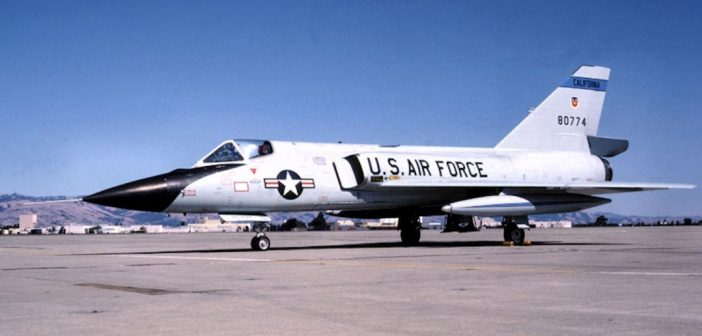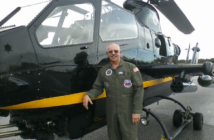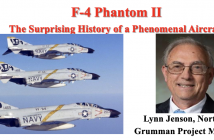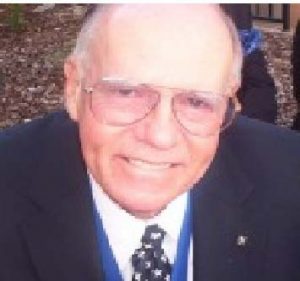 Colonel Ettinger had previously completed a distinguished career in the US Air Force, where he flew many combat missions over North Vietnam, flew as a test pilot on numerous systems, directed test organizations, and ultimately, served as Vice Commander of the Air Force Flight Test Center, at Edwards Air Force Base. He is sure to have some fascinating and exciting stories to share with us. Bob received a BS degree in Mechanical Engineering and an ROTC commission in the Air Force from UC Berkeley in 1959. While Pilot Training in Texas he flew the T-34, T-37 and the T-33. Bob entered Advanced Air Defense Interceptor Training in the F-102. During this 3-year, 8-month assignment, Bob survived a night head-on collision at about 1,000 knots closing speed and spent 8 hours in 55° water 100 miles off the eastern shore of Northern Japan.
Colonel Ettinger had previously completed a distinguished career in the US Air Force, where he flew many combat missions over North Vietnam, flew as a test pilot on numerous systems, directed test organizations, and ultimately, served as Vice Commander of the Air Force Flight Test Center, at Edwards Air Force Base. He is sure to have some fascinating and exciting stories to share with us. Bob received a BS degree in Mechanical Engineering and an ROTC commission in the Air Force from UC Berkeley in 1959. While Pilot Training in Texas he flew the T-34, T-37 and the T-33. Bob entered Advanced Air Defense Interceptor Training in the F-102. During this 3-year, 8-month assignment, Bob survived a night head-on collision at about 1,000 knots closing speed and spent 8 hours in 55° water 100 miles off the eastern shore of Northern Japan.
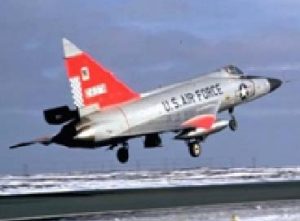 After training replacement crews for the F-4 for two years at Elgin AFB, Florida, he joined the 435th Tactical Fighter Squadron and the 8th Tactical Fighter Wing flying the F-4D at Ubon Royal Thai Air Base. He was part of a special six aircrew team trained in the TV guided Walleye glide bomb. These were the first examples of terminally guided bombs that could drop a bridge with a single1,000-pound bomb. Previously it had required 8 flights of 4 with eight 750-pound bombs each to drop the same bridge. The recent Iraqi War was initially completed in a matter of days using almost exclusively terminally guided GPS bombs. Bob flew 130combat missions during the Vietnam War, including 100 over North Vietnam. In 1968 he was selected for the Aerospace Research Pilot School (ARPS) at Edwards AFB. To qualify for this assignment, he took the Astronaut Flight Physical made famous by the movie the Right Stuff. The decision to subject himself to this week-long physical required serious consideration since it left one in thirty pilots irrevocably grounded by some obscure ailment that never would have been discovered by a normal annual flight physical. ARPS consisted of a very strenuous 12-month course of aerodynamics and flight test training including atmosphere flight test and space flight. Bob also flew docking training simulators and zero-g training aircraft. During training he managed to eject from a burning F-104 Starfighter without injury. Colonel Ettinger was assigned to the 4950th Test Wing at Wright-Patterson AFB, Ohio in 1969. He flew many systems tests in the F-4 and F-100. Bob’s most significant flight testing during this assignment was the development of the Survivable Flight Control System F-4 Fly-by-Wire system. During his four year tour at WPAFB Colonel Ettinger earned a Master’s Degree in Aeronautical Engineering from Ohio State University. In 1974 Colonel Ettinger returned to Edwards AFB as Chief of the F-4 Test Team and later a member of the Lightweight Fighter Joint Test Force flying the YF-16 and YF-17. He then became project pilot for the Fighter Control Configured Vehicle (CCV) program, a YF-16 with vertical canards, which allowed flat turns or turns without banking. This was a research project for the Air Force Flight Dynamics Laboratory. When the F-16 entered full scale development, he served as the Operations Officer, and Director of the F-16 Combined Test Force, participating in all phases of the F-16 Full Scale Development. Bob was the first USAF pilot to fly F-16A #1 and F-16A #2. In 1979, he was the co-recipient of the Society of Experimental Test Pilots’ Iven C. Kincheloe “Test Pilot of the Year” award for the successful completion of the hazardous high angle of attack and departure from controlled flight testing of the fly-by-wire and relaxed stability F-16. In 1980, Colonel Ettinger returned to Wright-Patterson AFB as the Chief of the Flight Controls Division of the Flight Dynamics Laboratory. He joined the Aeronautical Systems Division as Director of the A-10 Systems Program Office (SPO) in 1981. In1982, he became the Director of the Fighter/Attack SPO. Colonel Ettinger rejoined the F-16 Program in 1983 as the Deputy Director of the F-16 SPO. He returned to Edwards AFB, CA in 1985 as the Vice Commander of the Air Force Flight Test Center. In this dream job for a test pilot, he had the opportunity to fly every fighter and trainer under test during his tour. Colonel Ettinger retired from the Air Force in 1987 to become an executive in the aerospace industry.
After training replacement crews for the F-4 for two years at Elgin AFB, Florida, he joined the 435th Tactical Fighter Squadron and the 8th Tactical Fighter Wing flying the F-4D at Ubon Royal Thai Air Base. He was part of a special six aircrew team trained in the TV guided Walleye glide bomb. These were the first examples of terminally guided bombs that could drop a bridge with a single1,000-pound bomb. Previously it had required 8 flights of 4 with eight 750-pound bombs each to drop the same bridge. The recent Iraqi War was initially completed in a matter of days using almost exclusively terminally guided GPS bombs. Bob flew 130combat missions during the Vietnam War, including 100 over North Vietnam. In 1968 he was selected for the Aerospace Research Pilot School (ARPS) at Edwards AFB. To qualify for this assignment, he took the Astronaut Flight Physical made famous by the movie the Right Stuff. The decision to subject himself to this week-long physical required serious consideration since it left one in thirty pilots irrevocably grounded by some obscure ailment that never would have been discovered by a normal annual flight physical. ARPS consisted of a very strenuous 12-month course of aerodynamics and flight test training including atmosphere flight test and space flight. Bob also flew docking training simulators and zero-g training aircraft. During training he managed to eject from a burning F-104 Starfighter without injury. Colonel Ettinger was assigned to the 4950th Test Wing at Wright-Patterson AFB, Ohio in 1969. He flew many systems tests in the F-4 and F-100. Bob’s most significant flight testing during this assignment was the development of the Survivable Flight Control System F-4 Fly-by-Wire system. During his four year tour at WPAFB Colonel Ettinger earned a Master’s Degree in Aeronautical Engineering from Ohio State University. In 1974 Colonel Ettinger returned to Edwards AFB as Chief of the F-4 Test Team and later a member of the Lightweight Fighter Joint Test Force flying the YF-16 and YF-17. He then became project pilot for the Fighter Control Configured Vehicle (CCV) program, a YF-16 with vertical canards, which allowed flat turns or turns without banking. This was a research project for the Air Force Flight Dynamics Laboratory. When the F-16 entered full scale development, he served as the Operations Officer, and Director of the F-16 Combined Test Force, participating in all phases of the F-16 Full Scale Development. Bob was the first USAF pilot to fly F-16A #1 and F-16A #2. In 1979, he was the co-recipient of the Society of Experimental Test Pilots’ Iven C. Kincheloe “Test Pilot of the Year” award for the successful completion of the hazardous high angle of attack and departure from controlled flight testing of the fly-by-wire and relaxed stability F-16. In 1980, Colonel Ettinger returned to Wright-Patterson AFB as the Chief of the Flight Controls Division of the Flight Dynamics Laboratory. He joined the Aeronautical Systems Division as Director of the A-10 Systems Program Office (SPO) in 1981. In1982, he became the Director of the Fighter/Attack SPO. Colonel Ettinger rejoined the F-16 Program in 1983 as the Deputy Director of the F-16 SPO. He returned to Edwards AFB, CA in 1985 as the Vice Commander of the Air Force Flight Test Center. In this dream job for a test pilot, he had the opportunity to fly every fighter and trainer under test during his tour. Colonel Ettinger retired from the Air Force in 1987 to become an executive in the aerospace industry.

